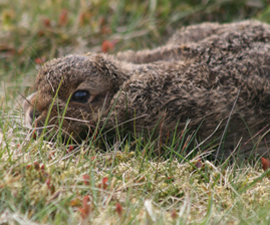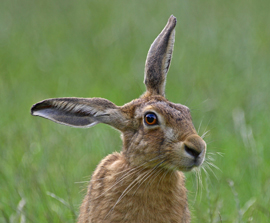-

A mountain hare leveret. Shely Bryan
-

Hares need protection. Andy Fisher/www.andyfisherphotography.co.uk
Despite having suffered a decline in population of up to 80 percent over the last century, hares are afforded little protection during their breeding season.
This cruel anomaly allows many thousands of pregnant and lactating females to be killed during the sensitive spring and summer months, as a result of which tens of thousands of dependent young (leverets) suffer and die.
Research undertake in Norfolk found that by February of the study year, 65 percent of sampled female hares were pregnant and by the end of that month, 50 percent had given birth to their first litter and were lactating [1]. A later survey in Scotland showed that in February, 47 percent of the female brown hares who were shot were pregnant. [2]
It is estimated that at least 300,000 hares are shot in Britain each year [3]. The most recent figure quoted, in 2012, by the Department for Environment, Food and Rural Affairs (DEFRA) is 390,000. This represents upto 50 percent of the pre-breeding population. Hare shoots are commonly held during February and March. [4].
Differences in levels of protection in the UK and Europe
In Scotland, the Wildlife and Natural Environment Act of 2011 [5], effective from 2012, makes it an offence to “intentionally or recklessly kill, injure or take brown hares [during their breeding season] from 1 February to 30 September (and mountain hares from 1 March to 31 July).
Much of mainland Europe, including Belgium, France, Germany, Ireland Spain and Sweden [6] already has legislation in place to protect hares during their breeding period and Northern Ireland has had such protection in place since 1928. [7]
By contrast in England, only a small amount of legal protection is provided for hares: through fragmented 19th century legislation giving some respite from shooting on moorland and unenclosed land from 1 April to 31 August [8], and through the banning of the sale of hares and leverets from 1 March to 31 July [9]. This legislation is clearly in need of modernisation.
Species Action Plan
The UK Biodiversity Action Plan recognises the role of legislation as a means of protecting species under pressure through exploitation, and the Species Action Plan for brown hares proposed a review of the use of legislation pertaining to the shooting and selling of hares in light of research findings on the seasonality of their reproduction [10].
With the Species Action Plan having failed to achieve its target, set in 1995, of doubling the springtime numbers of hares by 2010 [10] , it is time for the government to introduce legislation to give protection to these creatures during their breeding and nursing periods when they are at their most vulnerable.
HSI UK believes that urgent action must now be taken to protect hares and to encourage an increase in population, as envisaged by the Species Action Plan.
1. Lincoln, G A (1974) Reproduction and ‘March madness’ in the brown hare, Lepus europaeus. Journal of Zoology, London, 174. 1-14.
2. Evidence given to the Rural Affairs and Environment Committee, Scotland, 29 September 2010 by Ron Macdonald, head of policy and advice, Scottish Natural Heritage. http://www.scottish.parliament.uk/parliamentarybusiness/28862.aspx?r=5775&mode=html#iob_51801
3. Natural England, Species Information Note SIN001. http://naturalengland.etraderstores.com/NaturalEnglandShop/SIN001
4. The Committee of Inquiry into Hunting with Dogs in England and Wales, June 2000 (Burns report). Section 5: Population Management and Control, Hares (pages 98 – 102)
5. Wildlife and Natural Environment (Scotland) Act 2011 http://www.legislation.gov.uk/asp/2011/6/contents/enacted
6. An overview of the current status and protection of the Brown Hare (Lepus europaeus) in the UK. A report prepared for European Wildlife Division, Defra by Dr David Cowan, Central Science Laboratory, 2004. DEFRA.
7. Game Preservation Act (Northern Ireland) 1928. http://www.legislation.gov.uk/apni/1928/25/contents
8. Ground Game Act 1880. http://www.legislation.gov.uk/ukpga/Vict/43-44/47/contents & Ground Game (Amendment) Act 1906. http://www.legislation.gov.uk/ukpga/Edw7/6/21/contents
9. Hares Preservation Act 1892. http://www.legislation.gov.uk/ukpga/Vict/55-56/8/contents
10. Biodiversity: The UK Steering Group Report Volume 2: Action Plans (Annex F and Annex G), 1995. JNCC. http://webarchive.nationalarchives.gov.uk/20110303145213/http://ukbap.org.uk/UKPlans.aspx?ID=410#3
